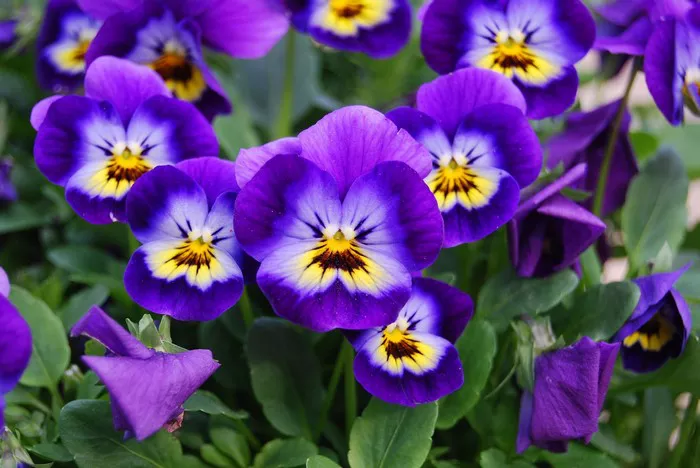The world of culinary arts is filled with an array of colors, flavors, and textures, and edible flowers have long been utilized to enhance dishes with their unique appearance and taste. Among these, purple flowers stand out for their vibrant hue and distinct flavor profiles. From delicate petals to robust blooms, edible purple flowers offer both visual appeal and culinary versatility. In this article, we will explore 10 edible purple flower varieties, their flavors, uses in cooking, and potential health benefits.
1. Lavender (Lavandula spp.)
Lavender, with its soothing fragrance and striking purple hue, is not only a popular choice for aromatherapy but also a versatile ingredient in the kitchen. Its delicate floral flavor adds a subtle sweetness to both sweet and savory dishes. Lavender can be used to infuse syrups, sauces, and desserts, or as a garnish for cocktails and salads.
2. Viola (Viola spp.)
Also known as Johnny-jump-up or wild pansy, Viola flowers come in various shades of purple and have a slightly sweet, grassy flavor. These petite flowers are often used to decorate cakes, pastries, and salads. They can also be crystallized or used to make herbal teas and infused oils.
3. Borage (Borago officinalis)
Borage is not only admired for its brilliant blue-purple flowers but also for its cucumber-like flavor. The star-shaped blooms are often used to garnish cocktails, soups, and salads. Borage flowers can also be candied or frozen into ice cubes for a decorative touch.
4. Chive (Allium schoenoprasum)
Chive flowers, which are the blossoms of the familiar chive herb, boast a delicate onion flavor with a hint of garlic. These purple pom-pom-like flowers are commonly used as a garnish for savory dishes, soups, and omelets. They can also be infused into vinegars or sprinkled over roasted vegetables for added flavor.
5. Sage (Salvia officinalis)
Sage, known for its aromatic leaves, also produces clusters of small purple flowers with a subtly sweet flavor. These flowers can be used fresh or dried to infuse syrups, sauces, and herbal teas with a hint of sage. They can also be fried as a crispy garnish or added to salads for a pop of color and flavor.
6. Nasturtium (Tropaeolum majus)
Nasturtiums are prized for their vibrant flowers, which range in color from pale lavender to deep purple. Both the flowers and leaves have a peppery, slightly spicy flavor reminiscent of watercress. Nasturtium flowers can be used to garnish salads, sandwiches, and hors d’oeuvres, or stuffed with cream cheese for an elegant appetizer.
7. Violets (Viola odorata)
Violets, with their delicate purple petals and sweet floral aroma, have been used in culinary applications for centuries. These edible flowers are often candied or used to make syrups, jellies, and liqueurs. Violets can also be added to salads, desserts, and herbal teas for a touch of color and flavor.
8. Elderflower (Sambucus nigra)
Elderflower, the creamy white flowers of the elder tree, can sometimes display hints of purple. These fragrant blossoms have a floral, slightly musky flavor that pairs well with citrus and berries. Elderflowers are commonly used to make syrups, cordials, and liqueurs, or dipped in batter and fried to make fritters.
9. Roselle (Hibiscus sabdariffa)
Roselle, also known as hibiscus, produces deep red-purple flowers that are rich in flavor and color. These tart flowers are commonly used to make teas, jams, and syrups, particularly in tropical regions. Roselle flowers can also be dried and ground into a powder for use as a natural food coloring or flavoring agent.
10. Butterfly Pea (Clitoria ternatea)
Butterfly pea flowers are known for their stunning indigo hue, which can impart a striking blue color to dishes and beverages. These flowers have a mild, earthy flavor and are often used to make herbal teas, cocktails, and desserts. Butterfly pea flowers can also be infused into vinegar or syrup for a unique culinary twist.
Health Benefits of Edible Purple Flowers
In addition to their culinary appeal, edible purple flowers offer a range of potential health benefits. Many of these flowers contain antioxidants, vitamins, and minerals that can support overall health and well-being. For example, lavender is prized for its calming properties and may help reduce stress and promote relaxation when consumed in tea or aromatherapy. Similarly, hibiscus flowers are rich in vitamin C and antioxidants, which can help boost the immune system and protect against oxidative stress.
Conclusion
Edible purple flowers add a pop of color, flavor, and nutritional value to a variety of dishes and beverages. From the delicate petals of lavender to the tart blooms of roselle, these flowers offer endless possibilities for culinary creativity. Whether used as a garnish, infusion, or main ingredient, edible purple flowers can elevate the aesthetic and taste of any dish. So, the next time you’re looking to add a touch of elegance to your cooking, consider incorporating one of these 10 delightful edible purple flower varieties.


